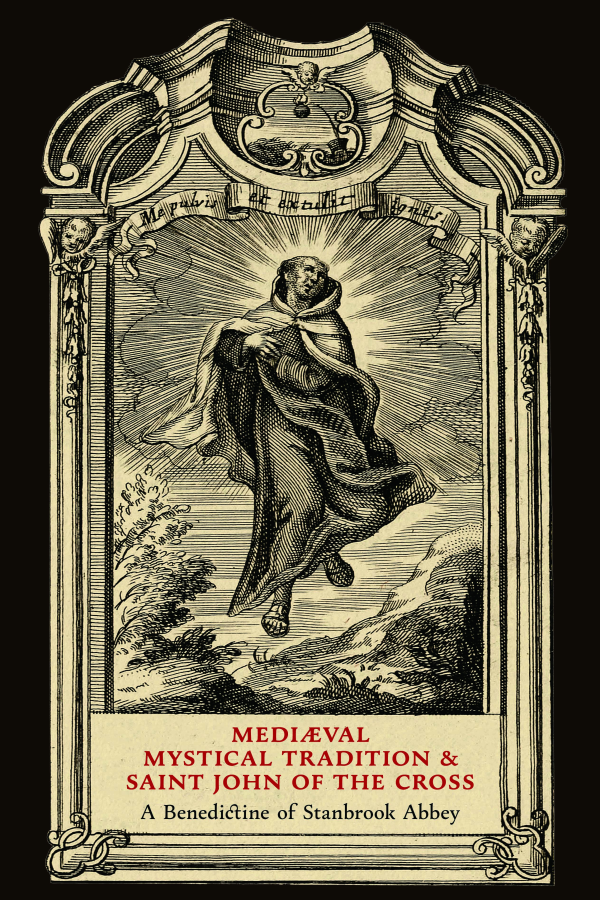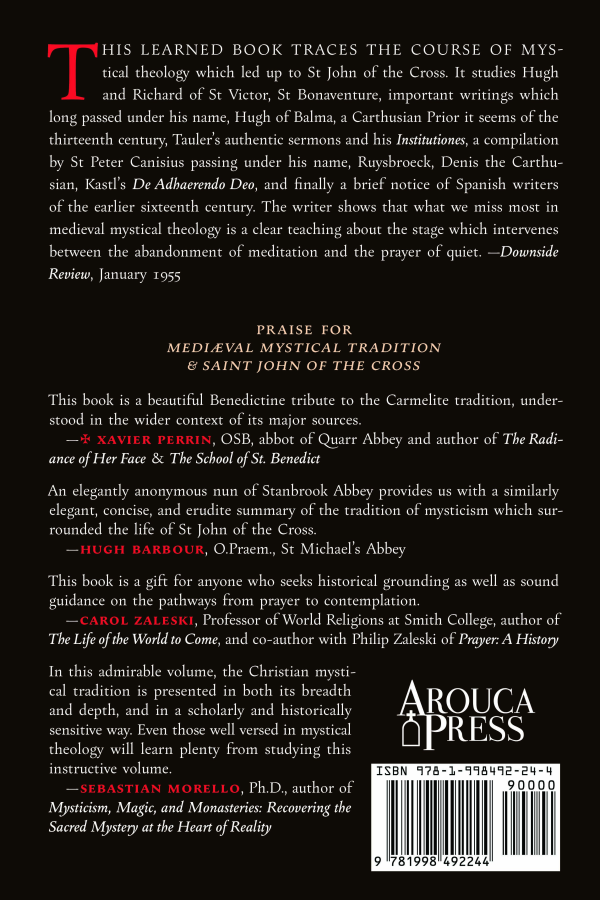Mediaeval Mystical Tradition and Saint John of the Cross
- Product Code: mmtsjc
- Publication date: February 12, 2025
- Pages: 166
- Size: 5.5 x 8.5
$17.95
-
Originally published in 1954.
This learned book traces the course of mystical theology which led up to St John of the Cross. It studies Hugh and Richard of St Victor, St Bonaventure, important writings which long passed under his name, Hugh of Balma, a Carthusian Prior it seems of the thirteenth century, Tauler’s authentic sermons and his Institutiones, a compilation by St Peter Canisius passing under his name, Ruysbroeck, Denis the Carthusian, Kastl’s De Adhaerendo Deo, and finally a brief notice of Spanish writers of the earlier sixteenth century. The writer shows that what we miss most in medieval mystical theology is a clear teaching about the stage which intervenes between the abandonment of meditation and the prayer of quiet. —Downside Review, January 1955
-
A Nun of Stanbrook Abbey, Dame Anselma Brennell (1891–1967), who is a sure guide in the forest of medieval mystical literature, leads us through complex issues of vocabulary, whilst presenting the various accounts of the encounter of souls with God. Experience is never far away. Erudition is entirely at the service of the mystery. This book is a beautiful Benedictine tribute to the Carmelite tradition, understood in the wider context of its major sources. —✠ Xavier Perrin, OSB, abbot of Quarr Abbey and author of The Radiance of Her Face & The School of St. Benedict
An elegantly anonymous nun of Stanbrook Abbey provides us with a similarly elegant, concise, and erudite summary of the tradition of mysticism which surrounded the life of St John of the Cross. With some understanding of the Carmelite doctor’s work, the reader of this study will easily realize why after St John of the Cross so much of the tradition from which he arose was overshadowed by his writings, too satisfyingly expressive of all he had received. Even so, a happy effect of this little work would be that readers acquaint themselves with this previous tradition, as they seek themselves to enter into his world. This work, combined with a work like Thomas Merton’s The Ascent to Truth would provide the earnest seeker with what is needed to peer into the stunning, broad, and attractive world of the Christian life of prayer —Hugh Barbour, O.Praem., St Michael’s Abbey
Since its founding four centuries ago, Stanbrook Abbey has been one of the great Benedictine centers of arts, letters, and scholarship. With a characteristic Stanbrook blend of spiritual warmth and intellectual rigor, Dame Anselma Brennell introduces us to a conversation across the ages involving monastics, mendicants, and lay mystics who sought to understand the stages of the spiritual life—and shows how this conversation (for all its divergent viewpoints) bore fruit in the profound mystical theology of St John of the Cross. This book is a gift for anyone who seeks historical grounding as well as sound guidance on the pathways from prayer to contemplation. —Carol Zaleski, Professor of World Religions at Smith College, author of The Life of the World to Come, and co-author with Philip Zaleski of Prayer: A History
There is one—and one only—unqualified end of the Church, and that is the union of her members with the triune God. Thus, mystical transformation is the reason proper for the Church’s existence. In this admirable volume, the Christian mystical tradition is presented in both its breadth and depth, and in a scholarly and historically sensitive way. It is, in fact, a remarkably clear work about a topic elsewhere often replete with obscurities. John of the Cross is revealed to be to mystical theology what Thomas Aquinas was to theology in general: “God’s Goldfinch” is the universal doctor on the subject of mystical transformation. Moreover, far from some gnostic “ascent” of the “inner self” out of the world of experience, Carmelite detachment—the path of “nada”—is one of purification of all in oneself that might mistake creatures for their Creator, so as to really love the former insomuch as they glorify the latter; hence, in his love of nature, John of the Cross is compared herein to Francis of Assisi. Even those well versed in mystical theology will learn plenty from studying this instructive volume. —Sebastian Morello, Ph.D., author of Mysticism, Magic, and Monasteries: Recovering the Sacred Mystery at the Heart of Reality
Reviews (0)
Be the first to write a review for this product.




